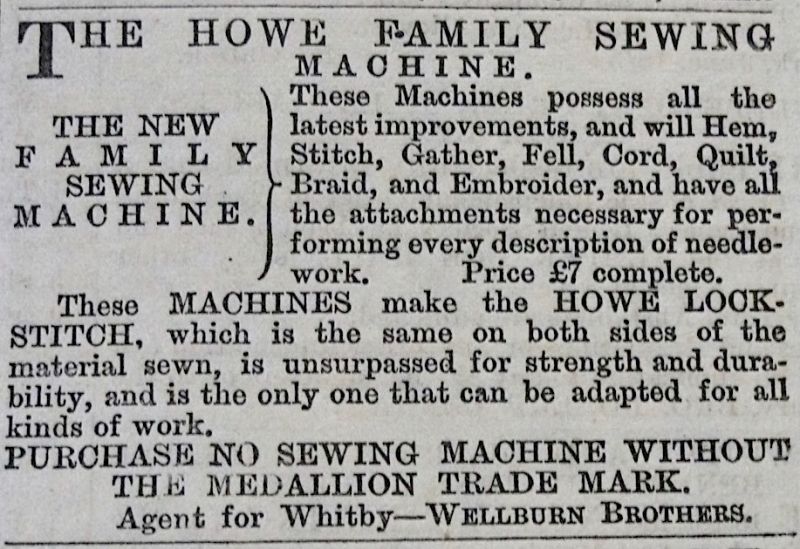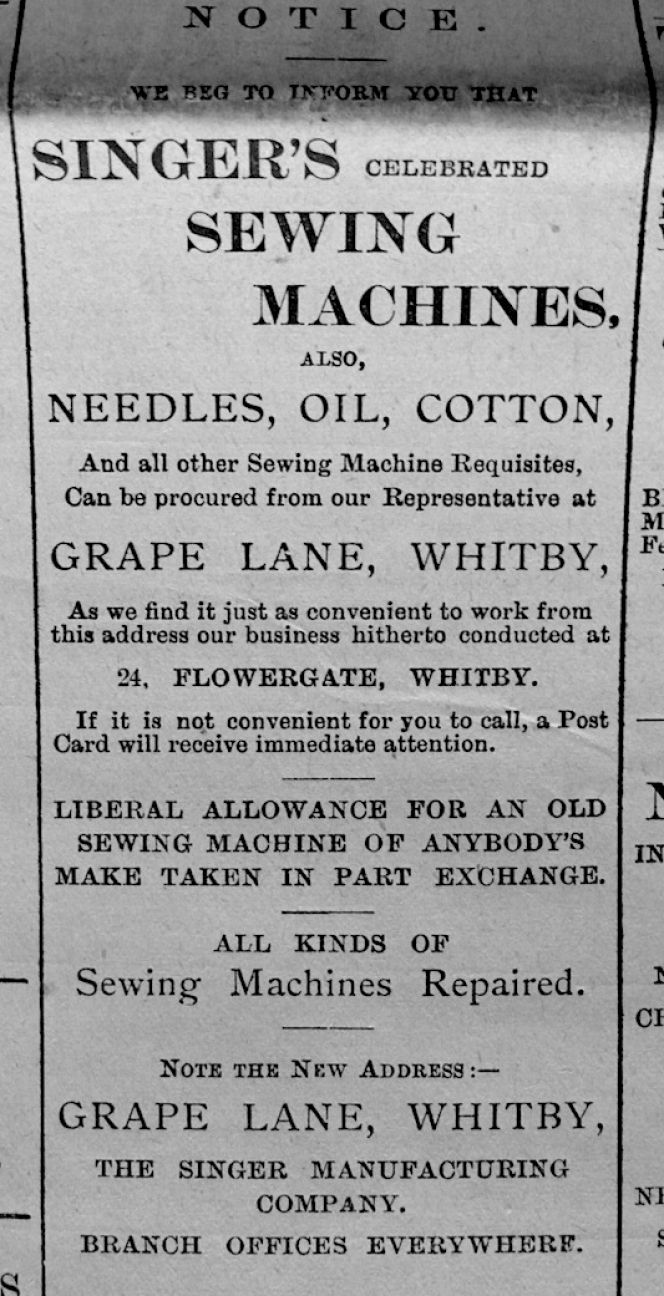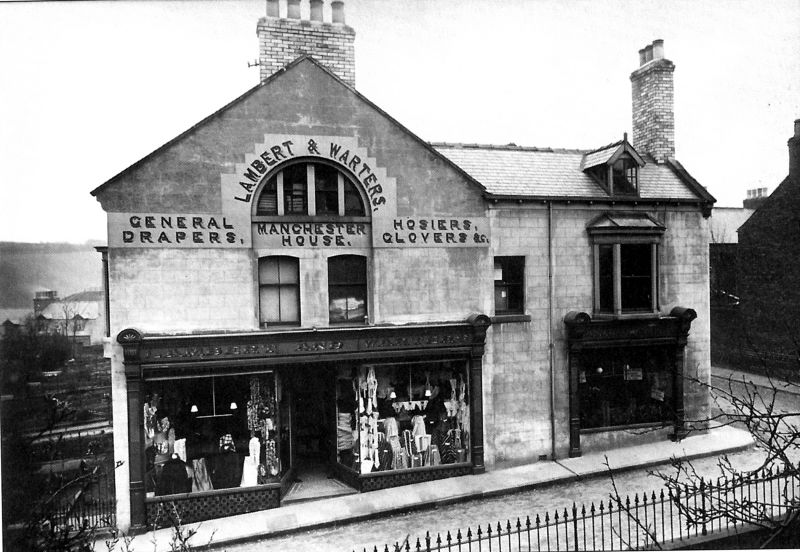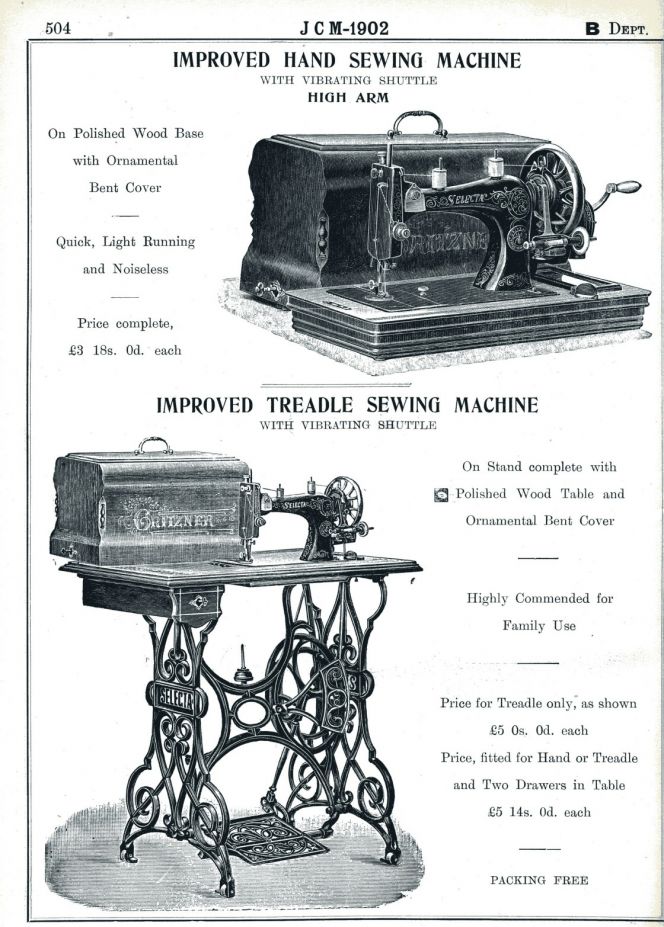ikfoundation.org
Promoting Natural & Cultural History



ESSAYS |
SELLING OF SEWING MACHINES
– Advertisements in a Local Newspaper from 1865 to 1914
The middle of the 19th century brought an important change to the manufacturing of clothes with the invention of the lock-stitch sewing machine, but this did not achieve any real breakthrough before the 1860s. Advertisers of the drapery trade looking for labour in the local newspaper, Whitby Gazette, sometimes mentioned the ability to work with a sewing machine, which seems to have been highly valued by employers, and from 1865, various types of machines were also offered for sale in Whitby shops. These advertisements over the period gave information about seven different producers, making sewing machines at various prices and particularly emphasising – speed, highest quality, superiority, beauty of finish and durability.
 Whitby Gazette in April 1875, Advertisement for Howe Family Sewing Machine, ‘Price £7 complete’. (Collection: Whitby Museum, Library & Archive). Photo: Viveka Hansen, The IK Foundation, London.
Whitby Gazette in April 1875, Advertisement for Howe Family Sewing Machine, ‘Price £7 complete’. (Collection: Whitby Museum, Library & Archive). Photo: Viveka Hansen, The IK Foundation, London.In December 1865, ‘The Wanzer Lock Stitch Sewing Machine’ was advertised. This could be bought through its Whitby agent, the bookseller S. Reed, and it was presented as:
- ‘Simple in construction, easy to learn, and not liable to get out of order. The machines are sure in their operation, and finish work in a uniformly perfect manner. Any number of cotton threads, or silk, can be used directly from the spool, and they sew equally well the lightest or heaviest woollen fabrics.’
Wanzer & Co. was a Canadian firm that started producing sewing machines in 1858, but as early as 1863, they had a branch in London that could distribute machines to customers in Great Britain. Wheeler & Wilson, established in the USA in 1856, also soon opened a London branch (1859) to sell more of their very popular machines. They, too, advertised in the Whitby Gazette, for example, in January 1867, when the reader was informed that their machine could be imported through Watson, Dobson & Co in Old Market Place. This is how its qualities were described:
- ‘Wheeler & Wilson’s Highest Premium Lock Stitch Sewing Machines, Always Highest overall Competitors it has no Equal. This Machine claims its Superiority over all others from its range of Work, Beauty of Finish, Nicety and Ease of Operation, inability to get out of Order, simplicity of Construction, and durability of Work when done. It has obtained a Popularity unparalleled in the History of Inventions. Over 200.000 have been Made and Sold.’
A third make of sewing machines, as advertised in December 1873, was ‘Weir’s 55s Sewing Machine’, sold through its agent, I. Langdale of 61 Baxtergate in Whitby. This had been patented by J. Weir in 1872 in London, and the ‘55s’ in its name reminded prospective buyers that it sold at the very favourable price of fifty-five shillings. In fact, the advertisement revealed that it was now available at ‘the reduced price of Two Guineas’, or only forty-two shillings. Particular qualities were also claimed for these machines: ‘Silent Spiral Gears, Safety Stitch Regulator, Improved Needle Slide, Oiling Holes and other Serviceable specialities... Works by Hand or Foot...’.
The drapers Wellburn Brothers were agents for a fourth type of sewing machine of a relatively expensive kind, the Howe Sewing Family Machine, as can be seen in this advertisement (image above) from spring 1875. The Howe Machine Company was produced in 1865 by the Stockwell Brothers, even if this lock stitch machine had already been patented as long ago as 1846 by Elias Howe. Since 1867, the firm had a branch in London, whose function was to sell machines for the constantly growing market in Great Britain with the help of agents like Wellburn Brothers of Whitby.
 Whitby Gazette in July 1898, Advertisement for Singer Sewing Machines. (Collection: Whitby Museum, Library & Archive). Photo: Viveka Hansen, The IK Foundation, London.
Whitby Gazette in July 1898, Advertisement for Singer Sewing Machines. (Collection: Whitby Museum, Library & Archive). Photo: Viveka Hansen, The IK Foundation, London.A fifth variety of sewing machine was advertised from the 1870s and afterwards through Singer, which had first started production in the USA in 1853, and opened its first British factory at Clydebank close to Glasgow in 1867. In October 1897, they explained that: ‘District Agent F. Moiser, c/o Mrs Sleightholme, 163 Church Street, Whitby. Begs to inform the Public of Whitby and the surrounding District that they can be supplied with Singer’s Sewing Machines and all accessories in the trade by applying to the above address. Price Lists free on application. Weekly payments taken. Good allowances for old machines taken in part exchange. Letters promptly attended to.’ The year after – in 1898 – Singer’s products were also sold in another Whitby establishment, as illustrated in the image above.
 Lambert & Warters’ shopfront in the 1920s, though this General Draper which also sold sewing machines was already established at this address between 1890 and 1914 in Whitby. (Whitby Museum, Photographic Collection, unknown photographer).
Lambert & Warters’ shopfront in the 1920s, though this General Draper which also sold sewing machines was already established at this address between 1890 and 1914 in Whitby. (Whitby Museum, Photographic Collection, unknown photographer).  Whitby Gazette in April 1900, “The White”, Hand Sewing Machine, sold by the General Draper illustrated above. (Collection: Whitby Museum, Library & Archive). Photo: Viveka Hansen, The IK Foundation, London.
Whitby Gazette in April 1900, “The White”, Hand Sewing Machine, sold by the General Draper illustrated above. (Collection: Whitby Museum, Library & Archive). Photo: Viveka Hansen, The IK Foundation, London.This sixth make of sewing machine, from the White Sewing Machine Company, was sold through the Drapers Lambert and Warters and featured, among other things, in this kind of small advertisement from spring 1900. This was another company that started up in the USA during the 1850s and established its market position in Great Britain through a London office in 1880.
Yet a seventh product advertising in this period when the sewing machine was promoted as indispensable for all sewing purposes was sold by Agar & Son of Flowergate in Whitby, who in April 1904 were described as ‘Agents for Faudel Sewing Machines, No.7 Treadle machine (with cover) £3/18/6’. This was a German make produced by Haid and Neu and imported by Faudels of London. The German manufacturers had been established in 1860 and, by 1904, had sold a million machines. In October 1913, a firm called itself Sewing Machine Co. Ltd. and advertised without specifying any particular brand. Instead, the reader was informed that this was where you could have your sewing machine serviced and oiled by a firm with ‘ten years’ experience’.
 General Catalogue in 1902 by ‘Richd Johnson, Clapham & Morris... Manchester and Liverpool’ demonstrating yet another way of dealing in sewing machines. Either a sales agent in a small town like Whitby could help by providing a catalogue like this one and taking orders, or possibly the customer could order a sewing machine from the firm directly via post, telegram or telephone. (From: J C M Catalogue 1902, Sewing machines p. 504.)
General Catalogue in 1902 by ‘Richd Johnson, Clapham & Morris... Manchester and Liverpool’ demonstrating yet another way of dealing in sewing machines. Either a sales agent in a small town like Whitby could help by providing a catalogue like this one and taking orders, or possibly the customer could order a sewing machine from the firm directly via post, telegram or telephone. (From: J C M Catalogue 1902, Sewing machines p. 504.)Sources:
- Hansen, Viveka, The Textile History of Whitby 1700-1914 – A lively coastal town between the North Sea and North York Moors, London & Whitby 2015. (pp. 130-31). | More about the use of sewing machines, dressmakers, seamstresses, needlewomen, milliners, tailors, outfitters, clothiers etc. in Whitby, pp. 182-241.
- Richd. Johnson, Clapham & Morris Limited, General Catalogue, Manufacturers, Merchants, Hardware factors and Complete house Furnishers, Manchester 1902.
- Whitby Gazette, 1860-1914 (Whitby Museum, Library & Archive).
- Whitby Museum, Library & Archive and Photographic Collection (Whitby Lit. & Phil.).
Essays
The iTEXTILIS is a division of The IK Workshop Society - a global and unique forum for all those interested in Natural & Cultural History from a Textile Perspective.
Open Access essays - under a Creative Commons license and free for everyone to read - by Textile historian Viveka Hansen aiming to combine her current research and printed monographs with previous projects dating back to the late 1980s. Some essays also include unique archive material originally published in other languages, made available for the first time in English, opening up historical studies previously little known outside the north European countries. Together with other branches of her work; considering textile trade, material culture, cloth manufacturing, fashion, natural dyeing and the fascinating world of early travelling naturalists – like the "Linnaean network" – from a Global history perspective.
For regular updates, and to make full use of iTEXTILIS' possibilities, we recommend fellowship by subscribing to our monthly newsletter iMESSENGER.
been copied to your clipboard




– a truly European organisation since 1988
Legal issues | Forget me | and much more...
It is free to use the information/knowledge in The IK Workshop Society so long as you follow a few rules.
 LEARN MORE
LEARN MORE








